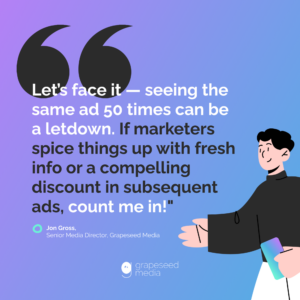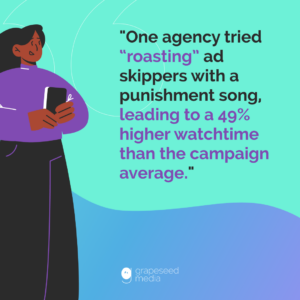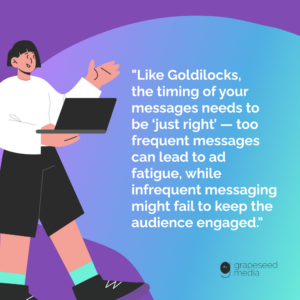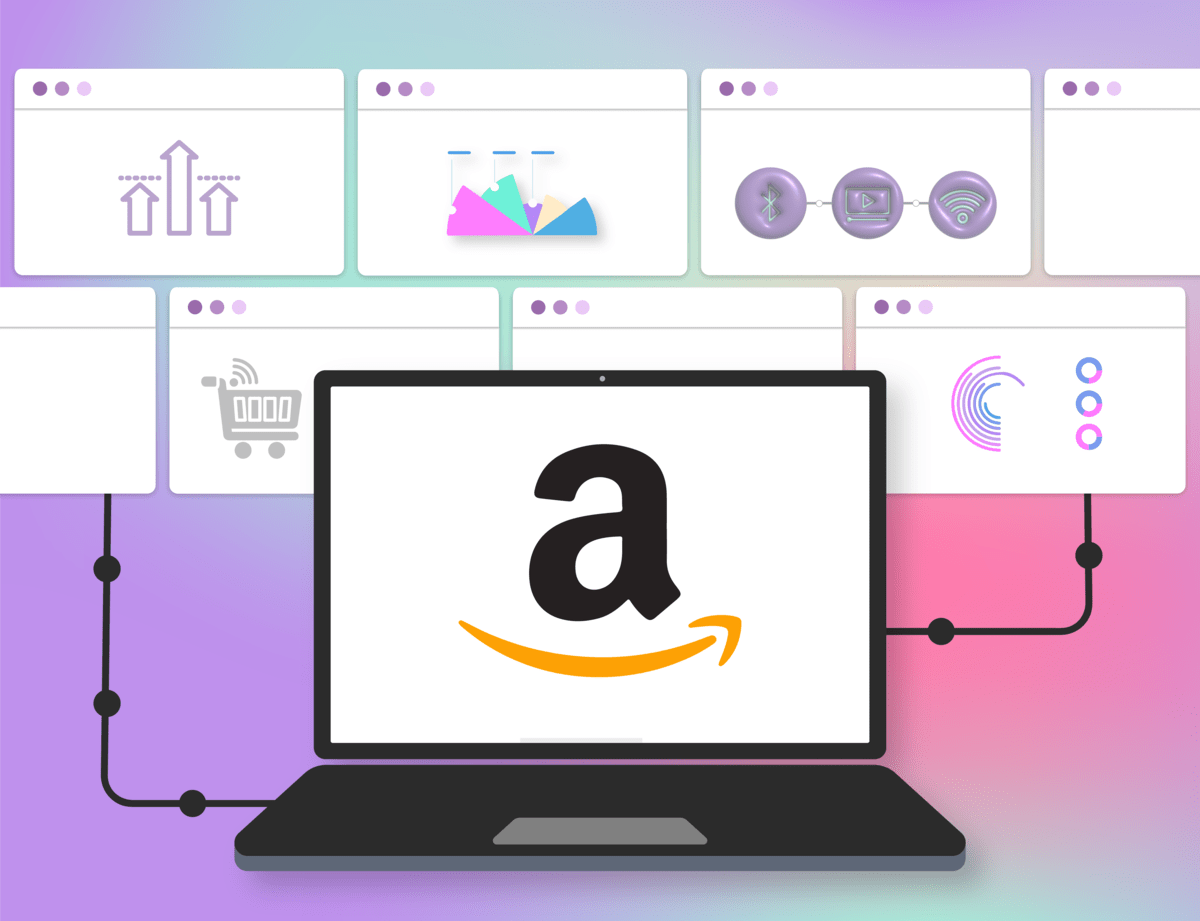Stories are powerful; they can help us convey meaning, uncover truths, and connect to those around us.
Advertisers have long known this — just look at the UK’s John Lewis Christmas ads, which have reached cult status since they began telling heartwarming stories in 2007.
Sequential messaging takes the concept of storytelling in ads one step further, delivering messages as part of a planned sequence rather than standalone units.
With the average person exposed to hundreds of ads per day (and probably not the much-cited 10,000), ad blindness and fatigue are a real challenge for advertisers — and sequential ads offer a solution.
As a consumer, I appreciate ads from brands that catch my interest, but let’s face it — seeing the same ad 50 times can be a letdown. If marketers spice things up with fresh info or a compelling discount in subsequent ads, count me in!
Want to know how sequential messaging works and how to get it right? Read on to discover how to craft sequential campaigns for better engagement and more conversions.

What Is Sequential Messaging?
Through sequential messaging, marketers aim to guide the audience through a narrative or a series of concepts over time, enhancing message retention and engagement. Here’s how it works:
Storytelling: The messages are often structured like a story, with each subsequent message building on the previous one to keep the audience engaged and looking forward to the next part of the story.
Customization and personalization: You can tailor the sequence of messages based on the recipient’s previous interactions with the content. For example, if someone shows interest in a particular topic, the next message they receive might delve deeper into that topic.
Multi-channel delivery: Sequential messaging can occur across various platforms (such as email, video and audio streaming platforms, and even pDOOH) to create a cohesive and immersive experience.
Timing: The messages are carefully timed. The interval between messages is planned to keep the audience’s interest piqued without overwhelming them.
Goal-oriented: The sequence is designed to lead the audience towards a specific action or conclusion, such as making a purchase, signing up for a service, or changing a behavior or opinion.
Feedback loop: In some advanced implementations, the response of the audience to each message can influence the content and timing of subsequent messages, making the sequence more dynamic and responsive.
This allows for segmentation of viewers (those who view the content) and skippers (those who skip past it) and retargeting them in different ways.
For instance, one agency tried “roasting” ad skippers with a punishment song, leading to a 49% higher watchtime than the campaign average.

What Are the Benefits of Sequential Messaging in Marketing Campaigns?
From a marketer’s perspective, the data agrees — diverse messaging across the marketing funnel not only keeps users engaged but also boosts conversion rates, making it a win-win for both consumers and marketers alike.
By guiding the audience through a well-planned journey, sequential messaging can lead to higher conversion rates. It nurtures potential customers by providing them with the right information at the right time, eventually leading them to make a purchase or take a desired action.

Here are some of the benefits of sequential messaging that lead to those higher conversion rates.
1. Enhanced Audience Engagement and Re-engagement
By targeting different stages of the customer buying journey with different ads, sequential messaging keeps the audience engaged throughout their decision-making process.
Early messages might focus on brand awareness and product introduction, while later messages might emphasize product benefits, testimonials, or special offers. This approach helps to re-engage customers who might have shown initial interest but did not proceed to purchase.
2. Improved Message Retention
Since sequential messaging tells a story or conveys information over a series of messages, it helps with better retention.
People are more likely to remember information that’s presented in a structured and consistent manner over time rather than in a single, standalone ad.
3. Greater Personalization
Sequential messaging allows for greater personalization as it can be tailored based on the recipient’s interactions with previous messages.
For example, if a customer shows interest in a specific product feature, subsequent messages can focus more on that feature, creating a more relevant and engaging experience for the customer.
4. Reduced Ad Fatigue and ‘Banner Blindness’
Overexposure to repetitive ads can lead to ad fatigue and banner blindness, where audiences become desensitized to marketing messages.
Sequential messaging combats this by presenting fresh and varied content at each stage, keeping the audience interested and attentive.
5. Effective Retargeting
Sequential messaging is particularly powerful in retargeting campaigns, allowing marketers to create tailored messages based on how far a customer has progressed in their buying journey, such as:
- Quartile view or listens: You can track which part of a video or audio ad was played and retarget users who have viewed or listened to a certain percentage of the ad, indicating their level of interest.
- Site retargeting: By tracking users’ interactions on your website, you can create sequential messages that correspond to the pages or products they showed interest in.
- Click retargeting: If a user clicks on an ad but doesn’t convert, you can use sequential messaging to follow up with more detailed information or a special offer to re-engage them.
How to Create an Effective Sequential Messaging Strategy
1. Identify Your Audience
Understanding your audience and their customer journey is a key element in the effectiveness of sequential messaging campaigns, as knowing their preferences, behaviors, and demographics allows for the creation of highly personalized, engaging messages that are more likely to elicit a positive response.
Additionally, mapping the customer journey is essential as it involves different messaging strategies at various stages, like awareness, consideration, decision, and loyalty.
For instance, messages in the early stages might focus on brand introduction, those in the middle stages on product benefits, and later stages on closing the sale.
Recognizing the challenges, needs, and interests of your audience makes your messages more impactful and strengthens brand loyalty and retention.
Moreover, messages that align with the audience’s current stage in their journey are more likely to lead to conversions. A well-timed offer or discount can be the crucial final nudge needed for a customer in the decision stage.
Therefore, it’s crucial to get to know your audience before designing a sequential messaging campaign.
Content Creation and Storytelling
Creating compelling content that unfolds over time requires a strategic approach, where the narrative or key messages are delivered in stages, each adding a layer to the overall story or argument.
The content needs to be well-crafted and visually appealing, and the messaging should be clear and consistent across all stages, with each piece of content building on the last, guiding the audience towards the intended action or conclusion.
Here’s how to use three common messaging frameworks effectively in this context:
1. Gain, Logic, Fear (GLF)
This framework starts by highlighting the potential gains or benefits of using the product or service, appealing directly to the audience’s desires or aspirations.
The next phase involves providing logical explanations or evidence of how the product achieves these gains, such as showcasing features, effectiveness, or comparisons with alternatives.
The final stage addresses concerns or anxieties the audience might have. This could involve creating a sense of urgency (e.g., limited time offer) or scarcity (e.g., limited stock), compelling the audience to act promptly to avoid missing out.
Each message in the sequence builds on the previous one, leading the audience through a journey from desire through rational conviction to a fear of missing out.
2. Pain, Agitate, Solve (PAS)
This approach is particularly effective for products or services that solve specific problems. It starts by identifying and empathizing with the audience’s pain points or frustrations.
The next set of messages agitates these pains by highlighting the consequences of not addressing these issues, thereby intensifying the audience’s desire for a solution.
The final stage presents your product or service as the solution, offering relief and addressing their unmet needs.
This framework is powerful because it creates a strong emotional connection by showing an understanding of the audience’s challenges and then provides a satisfying resolution.
3. Storytelling
Using a narrative structure, storytelling engages the audience by building a connection on an emotional level.
The story typically starts by setting a scene or introducing characters that the audience can relate to. As it unfolds, it gradually integrates the product or service into the narrative in a way that feels natural and relevant.
The key here is to create empathy and emotional engagement before the product or service is presented as part of the solution or climax of the story.
This method is highly effective because humans are naturally drawn to stories and remember information better when it’s presented in a narrative format.
Channel Selection and Timing
Once you’ve identified your audience and chosen your framework, it’s essential to select the most appropriate channels and timings for the target audience and type of content being delivered.
Different audiences have varying preferences for how they receive information. For instance, younger demographics may be more engaged on social media platforms like Instagram or TikTok, while a professional audience might be more accessible through LinkedIn or email newsletters. Choosing the right channels ensures your message reaches your audience where they are most active and receptive.
While the content can be tailored to fit different platforms, maintaining a consistent brand voice and message is vital. Inconsistencies in messaging can confuse your audience and dilute your brand’s impact, while a consistent brand voice helps in building trust and recognition, making your sequential messaging campaign more effective.
Like Goldilocks, the timing of your messages needs to be ‘just right’ — too frequent messages can lead to ad fatigue, while infrequent messaging might fail to keep the audience engaged.

Timing should consider the time of day or week but also external factors such as seasonality, holidays, or major events relevant to your audience.
Performance tracking
Tracking campaign data is crucial for optimizing the performance of sequential messaging campaigns. By analyzing metrics such as click-through rates, engagement levels, and conversion rates, you can gain insights into what resonates with your audience.
This data helps identify which messages are most effective and which channels yield the best results. Based on these insights, you can adapt strategies for improved performance.
For example, if certain messages are not performing well, you can revise them or replace them with content that has shown higher engagement in the past.
Similarly, if a particular channel is not yielding desired results, efforts can be redirected to more effective channels.
Continuous monitoring and adjustment based on campaign data ensure that the messaging remains relevant and engaging, leading to better campaign outcomes and a higher return on investment.
Sequential Messaging and DCO: How to Create More Effective Ads
Combining sequential messaging with Dynamic Creative Optimization (DCO) can further boost your campaigns’ effectiveness.
While sequential messaging guides the audience through a narrative over time, DCO automatically adjusts ad creatives based on real-time data like user behavior, demographics, and context, ensuring that each ad is highly personalized and relevant.
Combining the two results in a powerful synergy: the audience receives a series of messages that are not only coherent and compelling but also individually tailored in real-time, greatly increasing the likelihood of engagement and conversion.
Craft Memorable Advertising Journeys with Grapeseed Media
Sequential messaging leverages the power of storytelling, personalization, and strategic timing to create more engaging, memorable, and effective ads that boost conversions and improve brand experience.
At Grapeseed Media, our expertise in crafting and executing seamless sequential messaging strategies ensures your brand’s story unfolds in a way that captivates and resonates with your audience.
By combining data-driven insights and creative excellence, we tailor each message to align perfectly with your audience’s journey.
Ready to transform your advertising approach and see remarkable results?
Contact the Grapeseed Media team today, and let’s create a narrative that elevates your brand to new heights.





